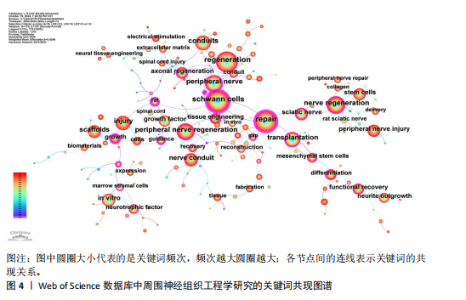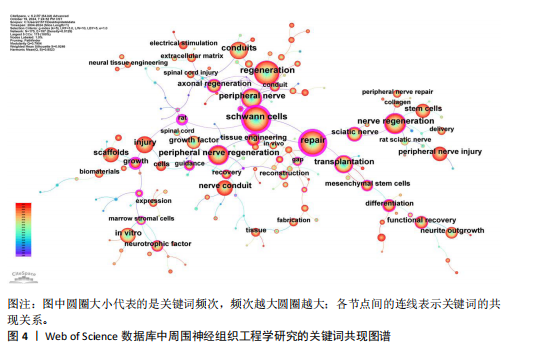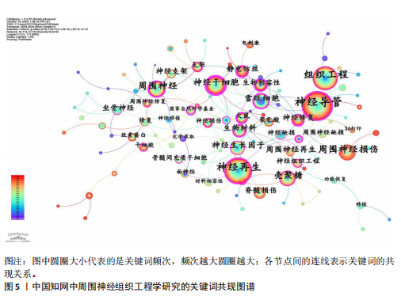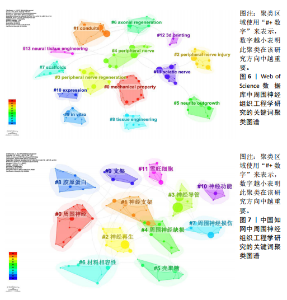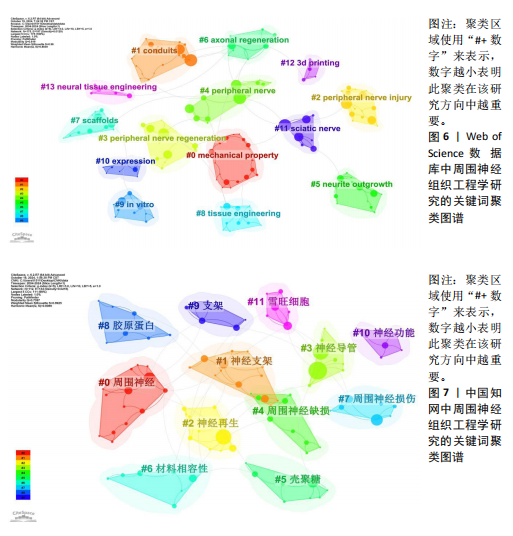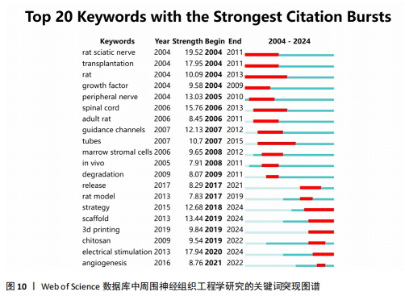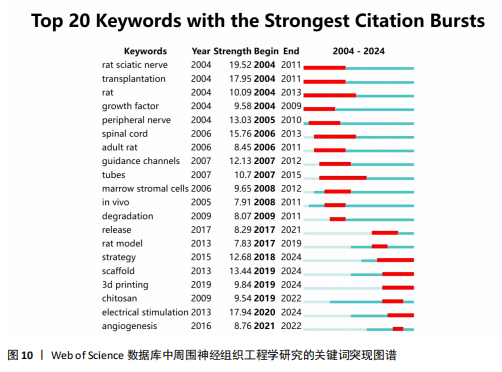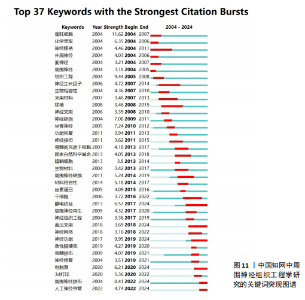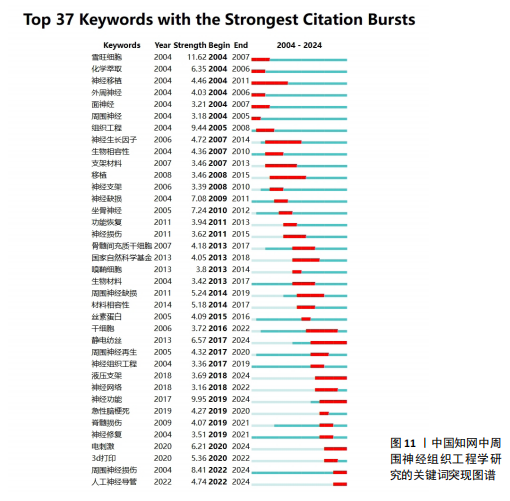Chinese Journal of Tissue Engineering Research ›› 2025, Vol. 29 ›› Issue (30): 6591-6600.doi: 10.12307/2025.935
Research hotspots and trends in application of tissue engineering in peripheral nerve injury
Zhao Xiaoxuan1, Liu Shuaiyi1, Xing Zheng2, Li Qingwen1, Chu Xiaolei2, Li Qi2
- 1Tianjin Key Laboratory of Sports Physiology and Sports Medicine, College of Exercise & Health, Tianjin University of Sport, Tianjin 301617, China; 2Tianjin Hospital, Tianjin 300211, China
-
Received:2024-10-25Accepted:2024-12-06Online:2025-10-28Published:2025-03-31 -
Contact:Chu Xiaolei, MD, Associate chief physician, Tianjin Hospital, Tianjin 300211, China -
About author:Zhao Xiaoxuan, Master candidate, Tianjin Key Laboratory of Sports Physiology and Sports Medicine, College of Exercise & Health, Tianjin University of Sport, Tianjin 301617, China -
Supported by:Tianjin Natural Science Foundation (General Program), No. 22JCYBJC00220 (to CXL); Tianjin Natural Science Foundation (General Program), No. 22JCYBJC00210 (to LQ); National Key R&D Program of China “Biology and Information Fusion (BT and IT Fusion)” (Key Special Project), No. 2023YFF1205200 (to XZ)
CLC Number:
Cite this article
Zhao Xiaoxuan, Liu Shuaiyi, Xing Zheng, Li Qingwen, Chu Xiaolei, Li Qi. Research hotspots and trends in application of tissue engineering in peripheral nerve injury[J]. Chinese Journal of Tissue Engineering Research, 2025, 29(30): 6591-6600.
share this article
Add to citation manager EndNote|Reference Manager|ProCite|BibTeX|RefWorks
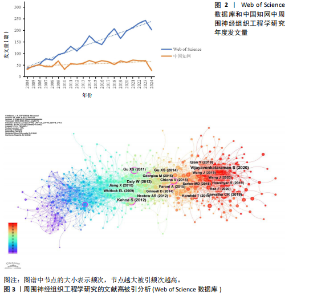
2.1 Web of Science数据库和中国知网周围神经组织工程学研究年度发文量趋势分析 分别在Web of Science数据库和中国知网中纳入了2 961,1 171篇文献,对年发文量进行统计,发现英文数据库中的周围神经组织工程学研究年度发文量呈不断增加趋势,而中文数据库检索到的周围神经组织工程学研究发文量虽增加但趋势不明显,2个数据库的发文量均有波动,见图2。 2.2 Web of Science数据库中周围神经组织工程研究高被引文献分析 文献高被引分析图谱中节点的大小表示频次,频次越高被其他文献引用的次数越高,就越能代表着该文献的经典性。图3为组织工程学治疗周围神经损伤相关研究的文献共被引图谱,表1总结了该领域引用次数最高的10篇文献,大多数为综述型文章。其中,大部分文献综述了目前神经组织工程学的设计方法、材料类型,总结了这些材料的优点和局限性;部分文献总结了细胞疗法与神经导管结合的重要性和有效性,例如在材料上吸附支持细胞、营养因子等;QIAN等[7]报道了一种集成3D打印和逐层浇注的多层多孔支架制造方法,这是引用前10文献中唯一的实验型文章,揭示了纳米技术在神经修复中的重要性。总之,良好的神经工程材料及神经工程方法在该领域中是研究的重点内容。 2.3 Web of Science数据库与中国知网中周围神经组织学研究关键词共现分析 在Web of Science数据库关键词共现分析中得到了175个节点,连线数为197,密度等于0.012 9,去除检索关键词和含义一致的关键词后,发现排名前几位的关键词是schwann cells(施万细胞)、regeneration(再生)、repair(修复)、injury(损伤)、transplantation (移植)、in vitro(体外)、sciatic nerve(坐骨神经)、growth factor(生长因子)、stem cells(干细胞)"
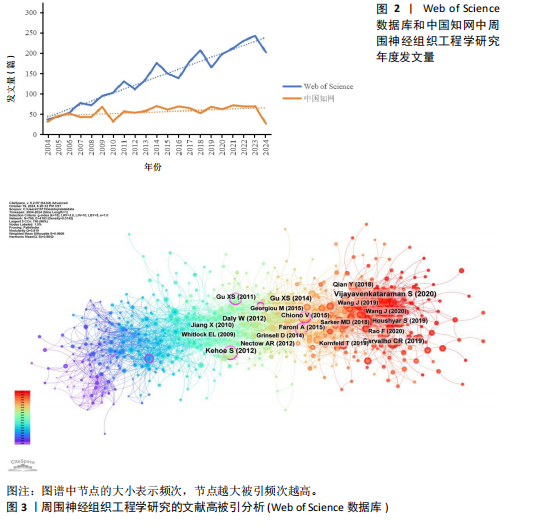
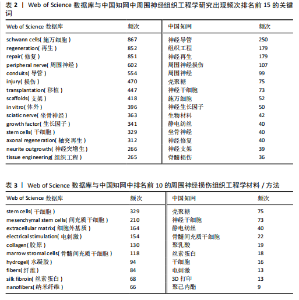
2.4 Web of Science数据库与中国知网中周围神经组织学研究关键词聚类分析 关键词网络聚类可以对关键词之间的相关性进行统计、分组,从而反映该领域的研究热点。其中,聚类的名称代表该领域研究的主要内容,聚类区域使用“# +数字”来表示,数字越小表明此聚类在该研究方向中越重要。 在Web of Science数据库关键词聚类分析中得到14个不同的集群:#0 mechanical property(机械性能)、#1 conduits(导管)、#2 peripheral nerve injury(周围神经损伤)、#3 peripheral nerve regeneration(周围神经再生)、#4 peripheral nerve(周围神经)、#5 neurite outgrowth(神经突生长)、#6 axonal regeneration(轴突再生)、#7 scaffolds(支架)、#8 tissue engineering(组织工程学)、#9 in vitro (体外)、#10 expression(表达)、#11 sciatic nerve(坐骨神经)、#12 3d printing(3D打印)、#13 neural tissue engineering(神经组织工程学),见图6,表4。聚类模块值(Q值)=0.819,聚类平均轮廓值(S值)=0.96,一般认为Q > 0.3意味着聚类结构显著,S > 0.7意味着聚类是令人信服的。 在中国知网关键词聚类分析中得到12个不同的集群:#0周围神经、#1神经支架、#2神经再生、#3神经导管、#4周围神经缺损、#5壳聚糖、#6材料相容性、#7周围神经损伤、#8胶原蛋白、#9支架、#10神经功能、#11施万细胞,见图7,表5。聚类模块值(Q值)=0.739 7,聚类平均轮廓值(S值)=0.892 5,因此两数据库的关键词聚类分析结构均显著,聚类结果较好。 2.5 Web of Science数据库与中国知网中周围神经组织工程学研究关键词时间轴分析 时间轴分析是关键词共现图和关键词聚类图的综合分析,此分析将每个聚类区域下的关键词以时间角度进行排列,并显示出某一聚类下的关键词在其他聚类区域下的共现情况。 从Web of Science数据库的关键词时间轴分析结果中可以得出:早在2004年,mechanical property(机械性能)就是神经组织工程学的研究重"
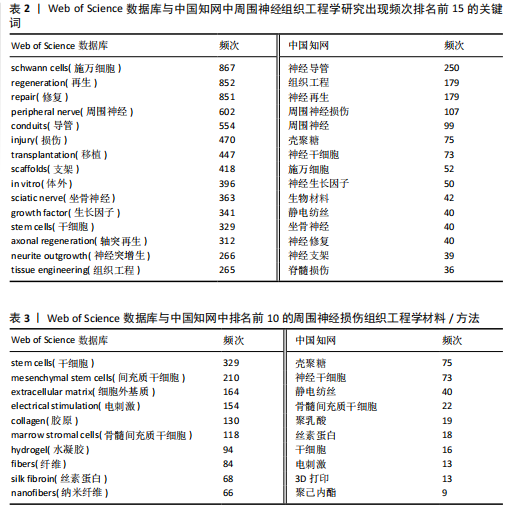
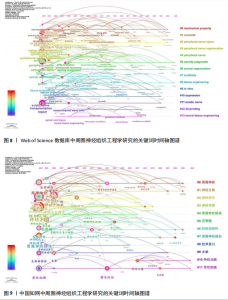
点且延续至今,说明了组织工程材料选取的重要性;biocompatibility(生物相容性)早期作为研究重点也说明了需要注重选材的安全性;extracellular matrix(细胞外基质)在神经再生过程中起到了结构支撑和信号传导的作用,作为良好的细胞材料,细胞外基质在早年就是神经导管中的重点物质;neurite outgrowth(神经突生长)、axonal regeneration(轴突再生)、tissue engineering(组织工程)一直是这20年来神经组织工程学的关键内容;大鼠的坐骨神经是神经组织工程学的重要研究选材,施万细胞作为周围神经系统中重要的胶质细胞[8],能分泌神经生长因子、形成髓鞘并引导轴突再生,因此它一直是神经组织工程学中的重点研究对象;近年来,随着工程技术的不断进步,神经导管的研究重点逐渐演变到了carbon nanotubes (碳纳米管),3D prining(3D打印),nanofibrous scaffolds(纳米纤维支架)等材料与技术,见图8。 中国知网的关键词时间轴分析结果显示:在2004年,壳聚糖、聚乳酸、丝素蛋白就作为研究重点并应用到神经修复中,同时神经导管不止应用到坐骨神经中,也开始用来治疗面神经瘫痪,并在2009年逐渐应用到脊髓损伤的患者中;值得注意的是,胶原蛋白在2005-2015年的研究较多,近些年相关研究较少;此外,静电纺丝技术、3D打印技术等方法在国内外都是近些年来的研究热点,见图9。 2.6 Web of Science数据库与中国知网中周围神经组织工程学研究关键词突现分析 关键词突现分析可以提取检测出的突变词,用来了解研究焦点的转变和最新的研究热点动态。此次研究在Web of Science数据库中分析得到了20个突现关键词(图10),中国知网中分析出了37个突现关键词(图11)。突现图中的Year表示该关键词第一次出现的年份,Begin和End表示该关键词作为前沿的起始和终止年份,红色线条代表该关键词成为学术研究热点的具体历时阶段。 在Web of Science数据库中可以看出早期研究的热点在于神经组织工程的研究对象上,一般使用成年大鼠的坐骨神经损伤模型验证效果。"

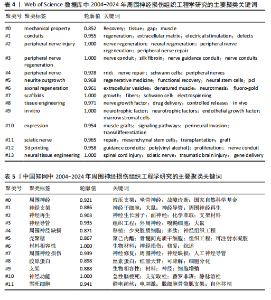
marrow stromal cells(骨髓间充质干细胞)具有强大的自我更新和分化的潜力[9],其可以分化为神经细胞,是构成神经支架/导管的重要因素。近年来,chitosan(壳聚糖)成为神经组织工程学中的研究热点,它作为一种天然多糖具有优越的生物相容性、生物降解性及良好的机械性能[10],可以充当神经支架的材料之一。electrical stimulation(电刺激)作为一种物理因子疗法,早在19世纪就成为治疗周围神经损伤的潜在治疗方式[11],如今它不止作为单纯的刺激方式,也可以将其引入神经导管/支架中,加速神经再生。 从中国知网中关键词突现的分析结果中可以看到,在2018年之前,“嗅鞘细胞”“丝素蛋白”“骨髓间充质干细胞”等生物材料或细胞疗法研究较多,随后“液压支架”“3D打印”等材料工程学成为了周围神经损伤治疗中的热门研究内容。近年来,周围神经修复不只关注神经再生情况,也将研究重点放在“神经功能”“神经网络”上,以期从更深入的角度来验证治疗方法的有效性。一直到2024年,周围神经损伤的组织工程学相关研究热点集中在“静电纺丝”“液压支架”“电刺激”几个方向。"
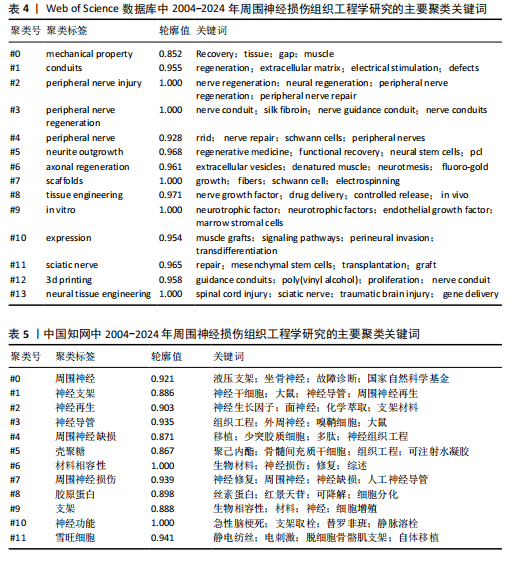
| [1] LI J, YAO Y, WANG Y, et al. Modulation of the Crosstalk between Schwann Cells and Macrophages for Nerve Regeneration: A Therapeutic Strategy Based on a Multifunctional Tetrahedral Framework Nucleic Acids System. Adv Mater. 2022; 34(46):e2202513. [2] LIU J, LI L, ZOU Y, et al. Role of microtubule dynamics in Wallerian degeneration and nerve regeneration after peripheral nerve injury. Neural Regen Res. 2022;17(3):673-681. [3] GOMEZ-SANCHEZ JA, PATEL N, MARTIRENA F, et al. Emerging Role of HDACs in Regeneration and Ageing in the Peripheral Nervous System: Repair Schwann Cells as Pivotal Targets. Int J Mol Sci. 2022;23(6): 2996. [4] MAENG WY, TSENG WL, LI S, et al. Electroceuticals for peripheral nerve regeneration. Biofabrication. 2022;14(4): 042002. [5] YANG X, HUANG L, YI X, et al. Multifunctional chitin-based hollow nerve conduit for peripheral nerve regeneration and neuroma inhibition. Carbohydr Polym. 2022;289:119443. [6] 王乐禹,邱小忠,王璞玥,等.组织工程研究的现状及应关注的重要基础科学问题[J].中国科学基金,2020,34(2):213-220. [7] QIAN Y, ZHAO X, HAN Q, et al. An integrated multi-layer 3D-fabrication of PDA/RGD coated graphene loaded PCL nanoscaffold for peripheral nerve restoration. Nat Commun. 2018;9(1):323. [8] ALVAREZ-SUAREZ P, GAWOR M, PROSZYNSKI TJ. Perisynaptic schwann cells - The multitasking cells at the developing neuromuscular junctions. Semin Cell Dev Biol. 2020;104:31-38. [9] CHU DT, PHUONG T, TIEN N, et al. An Update on the Progress of Isolation, Culture, Storage, and Clinical Application of Human Bone Marrow Mesenchymal Stem/Stromal Cells. Int J Mol Sci. 2020;21(3):708. [10] JAFERNIK K, LADNIAK A, BLICHARSKA E, et al. Chitosan-Based Nanoparticles as Effective Drug Delivery Systems-A review. Molecules. 2023;28(4):1963. [11] JUCKETT L, SAFFARI TM, ORMSETH B, et al. The Effect of Electrical Stimulation on Nerve Regeneration Following Peripheral Nerve Injury. Biomolecules. 2022;12(12):1856. [12] PHAMORNNAK C, HAN B, SPENCER BF, et al. Instructive electroactive electrospun silk fibroin-based biomaterials for peripheral nerve tissue engineering. Biomater Adv. 2022;141:213094. [13] AMAN M, MAYRHOFER-SCHMID M, SCHWARZ D, et al. Avoiding scar tissue formation of peripheral nerves with the help of an acellular collagen matrix. PLoS One. 2023;18(8):e289677. [14] MOATTARI M, KOUCHESFEHANI HM, KAKA G, et al. Chitosan-film associated with mesenchymal stem cells enhanced regeneration of peripheral nerves: A rat sciatic nerve model. J Chem Neuroanat. 2018;88:46-54. [15] MAGAZ A, FARONI A, GOUGH JE, et al. Bioactive Silk-Based Nerve Guidance Conduits for Augmenting Peripheral Nerve Repair. Adv Healthc Mater. 2018;7(23): e1800308. [16] DENG WS, MA K, LIANG B, et al. Collagen scaffold combined with human umbilical cord-mesenchymal stem cells transplantation for acute complete spinal cord injury. Neural Regen Res. 2020;15(9): 1686-1700. [17] XUAN H, TANG X, ZHU Y, et al. Freestanding Hyaluronic Acid/Silk-Based Self-healing Coating toward Tissue Repair with Antibacterial Surface. ACS Appl Bio Mater. 2020;3(3):1628-1635. [18] GU X, CHEN X, TANG X, et al. Pure-silk fibroin hydrogel with stable aligned micropattern toward peripheral nerve regeneration. Nanotechnology reviews (Berlin). 2021;10(1):10-19. [19] VERBOKET RD, HENRICH D, JANKO M, et al. Human Acellular Collagen Matrices-Clinical Opportunities in Tissue Replacement. Int J Mol Sci. 2024;25(13):7088. [20] FUHRMANN T, ANANDAKUMARAN PN, SHOICHET MS. Combinatorial Therapies After Spinal Cord Injury: How Can Biomaterials Help? Adv Healthc Mater. 2017;6(10):1601130. [21] 李晓寅,杨晓青,陈淑莲,等.胶原/丝素蛋白支架联合神经干细胞治疗创伤性脊髓损伤[J].中国组织工程研究,2023, 27(6):890-896. [22] GU X, DING F, WILLIAMS DF. Neural tissue engineering options for peripheral nerve regeneration. Biomaterials. 2014; 35(24):6143-6156. [23] 衣振伟,林浩东,赵黎明.壳聚糖支架在周围神经修复中的应用研究进展[J].功能高分子学报,2024,37(3):251-261. [24] YANG Z, ZHANG A, DUAN H, et al. NT3-chitosan elicits robust endogenous neurogenesis to enable functional recovery after spinal cord injury. Proc Natl Acad Sci U S A. 2015;112(43):13354-13359. [25] FAN W, GU J, HU W, et al. Repairing a 35-mm-long median nerve defect with a chitosan/PGA artificial nerve graft in the human: a case study. Microsurgery. 2008;28(4):238-242. [26] GU J, HU W, DENG A, et al. Surgical repair of a 30 mm long human median nerve defect in the distal forearm by implantation of a chitosan-PGA nerve guidance conduit. J Tissue Eng Regen Med. 2012;6(2):163-168. [27] NAWROTEK K, MAKIEWICZ M, ZAWADZKI D. Fabrication and Characterization of Polycaprolactone/Chitosan-Hydroxyapatite Hybrid Implants for Peripheral Nerve Regeneration. Polymers (Basel). 2021; 13(5):775. [28] CHEN T, JIANG H, LI X, et al. Proliferation and differentiation study of melatonin functionalized polycaprolactone/gelatin electrospun fibrous scaffolds for nerve tissue engineering. Int J Biol Macromol. 2022;197:103-110. [29] 刘星辰,高雪,张迪,等.新型有序排列复合磁性纳米微粒聚己内酯纤维神经导管促周围神经损伤修复的研究[J].空军军医大学学报,2023,44(6):503-508. [30] HSU SH, CHAN SH, CHIANG CM, et al. Peripheral nerve regeneration using a microporous polylactic acid asymmetric conduit in a rabbit long-gap sciatic nerve transection model. Biomaterials. 2011; 32(15):3764-3775. [31] SANTORO M, SHAH SR, WALKER JL, et al. Poly(lactic acid) nanofibrous scaffolds for tissue engineering. Adv Drug Deliv Rev. 2016;107:206-212. [32] ROCA FG, SANTOS LG, ROIG MM, et al. Novel Tissue-Engineered Multimodular Hyaluronic Acid-Polylactic Acid Conduits for the Regeneration of Sciatic Nerve Defect. Biomedicines. 2022;10(5):963. [33] 翟耘浩,钱运.碳纳米材料在周围神经再生领域的研究与应用[J].中国组织工程研究,2024,28(15):2423-2429. [34] 党小雯,黄海量,黄雷,等.生物医学领域碳纳米材料10年研究前沿与热点[J].中国组织工程研究,2025,29(4):752-760. [35] WEI C, GUO Y, CI Z, et al. Advances of Schwann cells in peripheral nerve regeneration: From mechanism to cell therapy. Biomed Pharmacother. 2024;175: 116645. [36] GUEROUT N, DUCLOS C, DROUOT L, et al. Transplantation of olfactory ensheathing cells promotes axonal regeneration and functional recovery of peripheral nerve lesion in rats. Muscle Nerve. 2011;43(4): 543-551. [37] KABIRI M, ORAEE-YAZDANI S, SHAFIEE A, et al. Neuroregenerative effects of olfactory ensheathing cells transplanted in a multi-layered conductive nanofibrous conduit in peripheral nerve repair in rats. J Biomed Sci. 2015;22(1):35. [38] WU W, ZHANG S, CHEN Y, et al. Biological Function and Mechanism of Bone Marrow Mesenchymal Stem Cells-packed Poly (3,4-ethylenedioxythiophene) (PEDOT) Scaffolds for Peripheral Nerve Injury: The Involvement of miR-21-Notch Signaling Pathway. Curr Neurovasc Res. 2017;14(1): 19-25. [39] CHENG FC, TAI MH, SHEU ML, et al. Enhancement of regeneration with glia cell line-derived neurotrophic factor-transduced human amniotic fluid mesenchymal stem cells after sciatic nerve crush injury. J Neurosurg. 2010;112(4):868-879. [40] WOOD MD, GORDON T, KEMP SW, et al. Functional motor recovery is improved due to local placement of GDNF microspheres after delayed nerve repair. Biotechnol Bioeng. 2013;110(5):1272-1281. [41] DONG C, QIAO F, HOU W, et al. Graphene-based conductive fibrous scaffold boosts sciatic nerve regeneration and functional recovery upon electrical stimulation. Appl Mater Today. 2020;21:100870. [42] LEE G, RAY E, YOON H J, et al. A bioresorbable peripheral nerve stimulator for electronic pain block. Sci Adv. 2022; 8(40):eabp9169. [43] PARK SC, OH SH, SEO TB, et al. Ultrasound-stimulated peripheral nerve regeneration within asymmetrically porous PLGA/Pluronic F127 nerve guide conduit. J Biomed Mater Res B Appl Biomater. 2010;94(2):359-366. [44] WU F, JIN L, ZHENG X, et al. Self-Powered Nanocomposites under an External Rotating Magnetic Field for Noninvasive External Power Supply Electrical Stimulation. ACS Appl Mater Interfaces. 2017;9(44):38323-38335. [45] OLARET E, DRAGUSIN DM, SERAFIM A, et al. Electrospinning Fabrication and Cytocompatibility Investigation of Nanodiamond Particles-Gelatin Fibrous Tubular Scaffolds for Nerve Regeneration. Polymers (Basel). 2021;13(3):l407. [46] 张丽萍,朱荔,穆德露,等.生物活性静电纺丝纳米纤维支架在乳房脂肪组织工程中的研究与应用进展[J].解放军医学院学报,2024,45(3):320-325. [47] 秦俊杰.多管道纤维神经导管的构筑及其用于周围神经损伤修复[D].北京:北京化工大学,2024. [48] DAI Y, LU T, LI L, et al. Electrospun Composite PLLA-PPSB Nanofiber Nerve Conduits for Peripheral Nerve Defects Repair and Regeneration. Adv Healthc Mater. 2024;13(10):e2303539. [49] MURPHY SV, ATALA A. 3D bioprinting of tissues and organs. Nat Biotechnol. 2014; 32(8):773-785. [50] MORRISON RJ, HOLLISTER SJ, NIEDNER MF, et al. Mitigation of tracheobronchomalacia with 3D-printed personalized medical devices in pediatric patients. Sci Transl Med. 2015;7(285):285ra64. [51] HU Y, WU Y, GOU Z, et al. 3D-engineering of Cellularized Conduits for Peripheral Nerve Regeneration. Sci Rep. 2016;6:32184. [52] TAO J, ZHANG J, DU T, et al. Rapid 3D printing of functional nanoparticle-enhanced conduits for effective nerve repair. Acta Biomater. 2019;90:49-59. |
| [1] | Lai Pengyu, Liang Ran, Shen Shan. Tissue engineering technology for repairing temporomandibular joint: problems and challenges [J]. Chinese Journal of Tissue Engineering Research, 2025, 29(在线): 1-9. |
| [2] | Liang Haobo, Wang Zeyu, Ma Wenlong, Liu Hao, Liu Youwen. Hot issues in the field of joint revision: infection, rehabilitation nursing, bone defect, and prosthesis loosening [J]. Chinese Journal of Tissue Engineering Research, 2025, 29(9): 1963-1971. |
| [3] | Yuan Weibo, Liu Chan, Yu Limei. Potential application of liver organoids in liver disease models and transplantation therapy [J]. Chinese Journal of Tissue Engineering Research, 2025, 29(8): 1684-1692. |
| [4] | Hu Taotao, Liu Bing, Chen Cheng, Yin Zongyin, Kan Daohong, Ni Jie, Ye Lingxiao, Zheng Xiangbing, Yan Min, Zou Yong. Human amniotic mesenchymal stem cells overexpressing neuregulin-1 promote skin wound healing in mice [J]. Chinese Journal of Tissue Engineering Research, 2025, 29(7): 1343-1349. |
| [5] | Jin Kai, Tang Ting, Li Meile, Xie Yuan. Effects of conditioned medium and exosomes of human umbilical cord mesenchymal stem cells on proliferation, migration, invasion, and apoptosis of hepatocellular carcinoma cells [J]. Chinese Journal of Tissue Engineering Research, 2025, 29(7): 1350-1355. |
| [6] | Li Dijun, Jiu Jingwei, Liu Haifeng, Yan Lei, Li Songyan, Wang Bin. Three-dimensional gelatin microspheres loaded human umbilical cord mesenchymal stem cells for chronic tendinopathy repair [J]. Chinese Journal of Tissue Engineering Research, 2025, 29(7): 1356-1362. |
| [7] | Lou Guo, Zhang Min, Fu Changxi. Exercise preconditioning for eight weeks enhances therapeutic effect of adipose-derived stem cells in rats with myocardial infarction [J]. Chinese Journal of Tissue Engineering Research, 2025, 29(7): 1363-1370. |
| [8] | Liu Qi, Li Linzhen, Li Yusheng, Jiao Hongzhuo, Yang Cheng, Zhang Juntao. Icariin-containing serum promotes chondrocyte proliferation and chondrogenic differentiation of stem cells in the co-culture system of three kinds of cells [J]. Chinese Journal of Tissue Engineering Research, 2025, 29(7): 1371-1379. |
| [9] | Huang Ting, Zheng Xiaohan, Zhong Yuanji, Wei Yanzhao, Wei Xufang, Cao Xudong, Feng Xiaoli, Zhao Zhenqiang. Effects of macrophage migration inhibitory factor on survival, proliferation, and differentiation of human embryonic stem cells [J]. Chinese Journal of Tissue Engineering Research, 2025, 29(7): 1380-1387. |
| [10] | Aikepaer · Aierken, Chen Xiaotao, Wufanbieke · Baheti. Osteogenesis-induced exosomes derived from human periodontal ligament stem cells promote osteogenic differentiation of human periodontal ligament stem cells in an inflammatory microenvironment [J]. Chinese Journal of Tissue Engineering Research, 2025, 29(7): 1388-1394. |
| [11] | Zhang Zhenyu, Liang Qiujian, Yang Jun, Wei Xiangyu, Jiang Jie, Huang Linke, Tan Zhen. Target of neohesperidin in treatment of osteoporosis and its effect on osteogenic differentiation of bone marrow mesenchymal stem cells [J]. Chinese Journal of Tissue Engineering Research, 2025, 29(7): 1437-1447. |
| [12] | Xie Liugang, Cui Shuke, Guo Nannan, Li Aoyu, Zhang Jingrui. Research hotspots and frontiers of stem cells for Alzheimer’s disease [J]. Chinese Journal of Tissue Engineering Research, 2025, 29(7): 1475-1485. |
| [13] | Li Jialin, Zhang Yaodong, Lou Yanru, Yu Yang, Yang Rui. Molecular mechanisms underlying role of mesenchymal stem cell secretome [J]. Chinese Journal of Tissue Engineering Research, 2025, 29(7): 1512-1522. |
| [14] | Cao Yue, Ye Xinjian, Li Biyao, Zhang Yining, Feng Jianying. Effect of extracellular vesicles for diagnosis and therapy of oral squamous cell carcinoma [J]. Chinese Journal of Tissue Engineering Research, 2025, 29(7): 1523-1530. |
| [15] | Sun Yuting, Wu Jiayuan, Zhang Jian. Physical factors and action mechanisms affecting osteogenic/odontogenic differentiation of dental pulp stem cells [J]. Chinese Journal of Tissue Engineering Research, 2025, 29(7): 1531-1540. |
| Viewed | ||||||
|
Full text |
|
|||||
|
Abstract |
|
|||||
